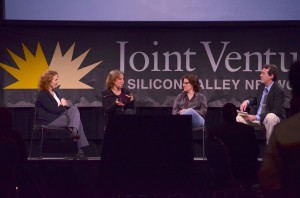
Mobile is the trend to watch – according to a panel of technology experts at Friday’s Joint Venture Silicon Valley’s State of the Valley Conference.
“It’s clear the mobile market is growing leaps and bounds and PCs are declining,” said Kim Polese, Chair of Consumer Finance at Clearstreet, Inc. “Companies are suffering if they’re basing their businesses on that.”
The discussion, which took place at Parkside Hall in San Jose, brought together three of the most influential women in tech: Polese, Kara Swisher, co-executive editor of All Things Digital and Susan Wojcicki, senior vice president of product at Google. Jon Swartz, tech team leader at USA Today, moderated the conversation.
With the explosion of smartphones occurring across all segments of the American population, Swisher said the mobile debate was over – mobile beat the desktop and there’s no going back. She likened the shift to the transportation revolution in the early 20th century, comparing horses to PCs and cars to mobile.
“You better stop riding that horse of yours,” Swisher said. “The desktops are done. Laptops are getting done. But tablets are the future. The mini iPad is a great device. It’s the future.”
Wojcicki agreed with Swisher. She said the current period of innovation is “probably the biggest revolution in computation. And that’s moving to mobile devices.”
When Swartz raised the question of whether Silicon Valley wasn’t too focused on mobile, Polese offered insight into what disruptive technologies may be emerging from mobile trends.
“We’re still using keys to open doors and plastic credit cards so clearly we haven’t yet reached the potential” that mobile can offer, Polese said.
In addition, there are still many challenges people face on a daily basis that are waiting for developers to solve through mobile and tablet applications, the group pointed out.
Furthermore, Polese acknowledged the mobile technology only penetrates a quarter of the world. This means there are still many more opportunities for mobile manufacturers to make a profit by pushing their devices on to emerging markets in developing countries.
Swartz pointed to the multiple screen phenomenon, mentioning that people in the Valley frequently will pull out an iPhone to use the apps and an Android to make calls. Wojcicki noted that children today don’t watch television anymore, preferring instead to snuggle up with a portable device to consume multimedia content.
Companies that fail to adapt to the new mobile standard could be left behind. The panel pointed to Facebook as a case in point. They highlighted the social media company’s need to improve the accessibility of its mobile app and generate effective ways to monetize its presence on the little screen. Swisher called Facebook “still a primarily desktop experience.”
The spike in mobile is starting to benefit many American semiconductor companies that are struggling because their bread-and-butter business relies on manufacturing hardware for PCs. A large number are shifting to mobile while they still address the problem of the flat lining PC market. In an interview after the panel, Polese said that what was anticipated years ago about mobile is finally starting to emerge. She called the migration to new devices these companies’ “only hope.”
One large sector of the tech industry that is not benefiting from mobile are the unwieldy public companies, set in their hardware ways, that dominated the late 20th century but are currently scrambling to find new strategies before they are overtaken by more agile enterprises focused on mobile and the web.
Dell, for instance, recently announced the company is turning back to private ownership in an effort to turn around the company. Hewlett-Packard also is facing challenges. The panelists were reluctant to discuss the flagging tech giant, although Swisher acknowledged the company was troubled by a lack of innovation.
“It’s hard to turn around a public company,” especially one the size of HP, said Polese in an interview.
Regardless of which companies float to the top, cell phone, tablets and other mobile devices are clearly here to stay Wojcicki concluded the discussion by saying, “These devices are becoming cheaper and cheaper and they’re becoming more accessible. The devices also become smaller and smaller.”
